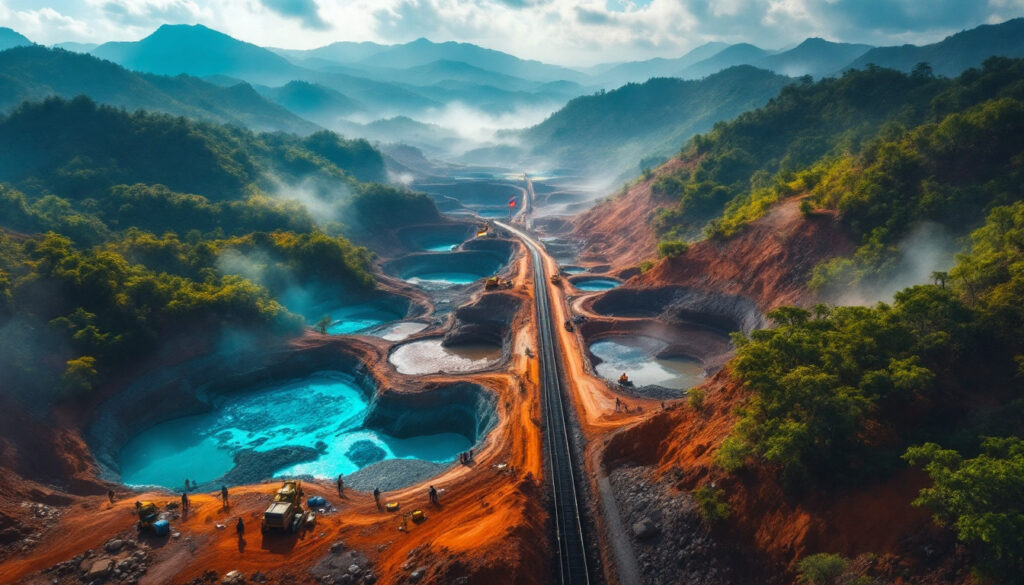Why Is the US Shifting Its Critical Minerals Strategy to Africa After Ukraine Deal?
The United States is strategically pivoting its critical minerals focus from Ukraine to Africa's Great Lakes region, driven by the Democratic Republic of Congo (DRC) and Rwanda's mineral wealth. This shift, marked by accelerated diplomatic engagement since February 2025, aims to counter China's dominance in mineral supply chains while addressing regional instability. Key developments include the M23 rebel group's territorial advances, the temporary shutdown of the Bisie tin mine, and ongoing peace negotiations mediated by Qatar. The US strategy mirrors its Ukraine model, offering security assistance in exchange for mineral beneficiation in South Africa and other resource-rich nations.
What's Behind America's New Mineral Security Strategy?
The United States is actively expanding its critical minerals strategy, with increasing attention on Africa's resource-rich regions. This pivot represents a significant critical minerals strategy shift following the Ukraine minerals deal, as America recognizes both the opportunity and urgency of securing alternative supply chains for technology-critical minerals.
America's renewed focus on African minerals stems from growing concerns about supply chain vulnerabilities exposed during recent global disruptions. The Biden administration has identified 50 minerals as "critical" to national security and economic prosperity, with many abundant in African nations, particularly the Democratic Republic of Congo (DRC).
"The race for critical minerals is essentially a race for technological dominance in the 21st century," notes a senior policy advisor at the US Department of State. "Africa possesses the resources that will power everything from smartphones to electric vehicles to defense systems."
The diplomatic engagement with Congo and Rwanda represents a strategic counterbalance to China's established dominance in the region. Since February 2025, US officials have conducted multiple high-level meetings with Congolese and Rwandan counterparts, aiming to broker peace while securing preferential mineral access.
Particularly notable is the timing of these initiatives. The DRC government approached the Trump administration in February 2025, coinciding with M23's capture of strategic cities including Goma and Bukavu. This outreach presented an opportunity similar to the successful Ukraine minerals model, where security assistance is exchanged for resource access.
The stakes became even clearer when the Bisie tin mine—producing 4% of global tin concentrates—shut down operations in March 2025 due to advancing M23 rebels. This disruption sent tin prices soaring 18%, demonstrating Congo's outsized influence on global mineral markets. Operations resumed on April 15, 2025, but the vulnerability was exposed.
The Strategic Value of Africa's Mineral Wealth
Unlike Ukraine's significance for titanium and lithium, Africa—particularly the Congo—offers access to a different but equally critical basket of minerals. The region is especially rich in the "3T minerals" (tin, tungsten, and tantalum) plus cobalt, with Congo holding an estimated 60% of global coltan reserves.
These minerals are indispensable for modern technology. Tantalum capacitors, derived from coltan, are irreplaceable components in smartphones and defense electronics. Tin is crucial for semiconductor manufacturing, while cobalt remains essential for electric vehicle batteries despite ongoing research into alternatives.
What makes this strategy particularly urgent is China's tightening grip on global mineral processing. As one industry analyst noted in Reuters, "While Western countries discuss diversification, China has spent decades cementing control over not just mining but processing infrastructure throughout Africa, particularly in Congo's copper belt."
The US approach appears multifaceted: brokering regional peace, establishing bilateral minerals deals, countering Chinese influence, and creating compliant supply chains that satisfy regulatory requirements like the Dodd-Frank Act's Section 1502 on conflict minerals.
Why Is the Great Lakes Region of Africa Strategically Important?
The African Great Lakes region, particularly eastern Congo, represents one of the planet's richest mineral depositories—and one of its most contested territories. The area's strategic importance has grown exponentially as demand for technology metals has surged worldwide.
The Mineral Treasure Trove of Eastern Congo
Eastern Congo's North and South Kivu provinces contain extraordinary concentrations of critical minerals in a relatively compact geographic area. Recent mapping exercises have documented approximately 2,800 mining sites across these provinces, with research teams from the International Peace Information Service (IPIS) confirming 829 active locations employing an estimated 132,000 miners between 2021-2023.
The diversity of minerals is remarkable, though patterns emerge: about 85% of these sites produce gold, while most others extract the strategically critical "3T minerals"—tin, tungsten, and tantalum (from coltan ore). These minerals collectively form the backbone of global electronics manufacturing.
"What makes eastern Congo unique isn't just the concentration of minerals, but their grade and accessibility," explains a mineral economist who specializes in Central African resources. "Many deposits lie near the surface, enabling extraction without sophisticated equipment—a double-edged sword that facilitates both legitimate business and conflict financing."
The coltan deposits are particularly significant, with Congo holding approximately 60% of global reserves. Tantalum derived from coltan is essential for manufacturing the miniaturized capacitors that enable modern electronics—from smartphones to missile guidance systems. A single smartphone contains roughly 40 milligrams of tantalum, meaning Congo's reserves are quite literally powering the digital revolution.
The Bisie Tin Mine: A Case Study in Risk and Opportunity
Perhaps no single operation better illustrates both the potential and perils of Congo's mineral wealth than the Bisie tin mine in North Kivu's Walikale territory. Operated by Alphamin Resources, this modern industrial operation represents a rare success story amidst regional turmoil.
Producing approximately 4% of global tin concentrates, Bisie employs over 1,200 workers under formalized conditions—a stark contrast to most artisanal operations in the region. The mine utilizes sophisticated traceability protocols to ensure its products qualify as "conflict-free" under international standards.
"Bisie demonstrates what's possible when mining is formalized and secured," notes Alphamin's CEO. "But even our operation remains vulnerable to regional instability."
This vulnerability became acutely apparent in March 2025, when advancing M23 rebels forced the mine's evacuation and temporary shutdown. The subsequent spike in global tin prices—rising 18% during the closure period—demonstrated the market's sensitivity to disruptions in Congo's mineral output.
Operations resumed on April 15, 2025, following diplomatic interventions and security guarantees, but the incident highlighted the precarious nature of even the most established mining operations in the region. For U.S. policymakers, Bisie represents both the promise of formalized mining in Congo and the urgent need for regional stabilization.
The Geopolitical Chess Board
Beyond the minerals themselves, eastern Congo's strategic importance is amplified by its position at the intersection of competing regional powers. Rwanda, Uganda, and Burundi all share borders with the mineral-rich provinces, creating complex cross-border dynamics that influence mineral flows.
Rwanda's alleged support for the M23 rebel group, which controls approximately 40% of North Kivu province, has complicated U.S. diplomatic efforts. While Rwanda officially denies backing M23, UN reports have repeatedly documented Rwandan military support, including equipment transfers and troop deployments.
The competition for mineral access extends beyond African nations. China has established dominant positions in Congo's mining sector, particularly in the southern Katanga province's copper-cobalt belt, where Chinese companies control approximately 80% of cobalt output. This Chinese dominance represents a direct challenge to U.S. efforts to secure supply chains for critical minerals energy security.
"The Great Lakes mineral trade isn't just about resources—it's about who controls the technologies of tomorrow. The nation that secures these supply chains gains leverage in industries ranging from renewable energy to defense." — Analysis from a senior resource security expert at the Council on Foreign Relations
What Triggered the US-Africa Minerals Initiative?
The catalysts for America's heightened interest in African minerals have been both strategic and reactive, representing a convergence of long-term planning and crisis response. Two particular events accelerated this engagement: the DRC government's outreach and the Bisie tin mine crisis.
The Congo Government's Strategic Outreach
In February 2025, the Democratic Republic of Congo government made a calculated diplomatic move, approaching the Trump administration with a proposal that paralleled the successful Ukraine minerals framework. This outreach wasn't merely opportunistic—it followed the rapid territorial expansion of the M23 rebel group, which had captured the strategic cities of Goma and Bukavu.
"The timing was strategic," explains a State Department official familiar with the negotiations. "Congo needed security assistance to counter M23's advances, while the U.S. was increasingly concerned about critical mineral access following supply disruptions in 2024."
The Congolese proposal offered preferential access to the country's vast mineral resources—particularly tin, tungsten, and tantalum—in exchange for security assistance and diplomatic support in resolving the conflict with Rwanda, which intelligence reports consistently link to M23 despite official denials.
This outreach resonated with evolving U.S. mineral security strategy, which had already identified African resources as potential alternatives to Chinese-dominated supply chains. Previous administrations had hesitated to deepen engagement due to governance and conflict concerns, but the precedent established by Trump's critical minerals order provided a workable framework.
The Bisie Tin Mine Crisis: Market Shock and Response
While diplomatic channels were already active, the situation gained urgency in March 2025 when M23 rebels advanced toward Walikale territory, home to the Bisie tin mine. As rebels approached within 30 kilometers of the mine, Alphamin Resources implemented emergency protocols, evacuating international staff and suspending operations at the world's fourth-largest tin producer.
The market response was immediate and severe. Global tin prices surged 18% over a two-week period, disrupting supply chains for semiconductor manufacturers already struggling with component shortages. The Bisie shutdown cost Congo approximately $12 million monthly in lost export taxes, further straining government finances.
"The Bisie crisis demonstrated Congo's outsized influence on critical mineral markets," notes a commodity analyst at Wood Mackenzie. "A single mine in North Kivu affected global electronics manufacturing—that's precisely the vulnerability Western governments are trying to address."
This market disruption accelerated U.S. diplomatic engagement. Within days of the mine closure, high-level discussions were underway in Qatar, where mediators worked to broker a cease-fire between Congo and Rwanda. The United States reportedly offered enhanced security cooperation contingent on progress toward a comprehensive peace agreement.
The diplomatic pressure yielded initial results by early April 2025, with M23 forces withdrawing from several areas as a goodwill gesture. This partial withdrawal, combined with security guarantees, enabled Bisie to resume operations on April 15, 2025, stabilizing global tin markets.
The Qatar-Mediated Peace Process
The peace negotiations initiated in March 2025 represent the most promising diplomatic breakthrough in years for the troubled Great Lakes region. Qatar, leveraging its growing role as a neutral mediator in global conflicts, has hosted multiple rounds of talks between Congolese and Rwandan officials.
These negotiations have progressed more rapidly than previous attempts, with analysts attributing the momentum to several factors:
- Increased U.S. diplomatic pressure on both parties
- The economic impacts of the Bisie shutdown
- Rwanda's interest in legitimizing its own mineral exports
- Congo's need for security assistance against multiple armed groups
By late April 2025, the framework for a potential agreement had emerged, including provisions for M23 demobilization, joint border security operations, and mechanisms to certify mineral origins. Analysts project a potential peace agreement as early as May 2025, though implementation challenges remain substantial.
"The peace process is inextricably linked to minerals access," explains a regional analyst. "Both the U.S. and the parties to the conflict understand that stabilizing eastern Congo is a prerequisite for establishing legitimate supply chains."
How Is the US-Africa Minerals Deal Taking Shape?
The emerging U.S.-Africa minerals framework represents an ambitious attempt to address multiple strategic objectives simultaneously: securing critical mineral access, promoting regional stability, countering Chinese influence, and developing ethically sourced supply chains.
Diplomatic Momentum and Peace Negotiations
Following the DRC's outreach in February 2025, the United States has engaged in intensive diplomatic efforts, leveraging both bilateral channels and multilateral forums to advance peace between Congo and Rwanda. These Qatar-mediated negotiations have shown encouraging progress, with M23 forces withdrawing from several contested areas by April 2025.
"The diplomatic approach demonstrates a more sophisticated U.S. understanding of African mineral politics," notes a regional security analyst. "Rather than attempting to secure resources without addressing root conflicts, this strategy recognizes that stability and access are interdependent."
The negotiations have focused on several core issues:
- The withdrawal and demobilization of M23 fighters
- Security arrangements for mining areas in North and South Kivu
- Verification mechanisms for mineral origins
- Revenue-sharing principles for border regions
Analysts anticipate a potential framework agreement as early as May 2025, though implementation will likely require sustained international engagement. The United States has reportedly offered security assistance packages to both Congo and Rwanda, contingent upon progress in the peace process.
A senior U.S. State Department official described the approach as "peace through economic development," adding that "sustainable mineral production benefits all parties more than conflict and smuggling."
Bilateral Minerals Agreements: Following the Ukraine Model
Concurrent with the peace process, the United States is working to establish bilateral minerals agreements with both Congo and Rwanda. These arrangements would create legal frameworks for preferential U.S. access to critical minerals while supporting regional stability.
The proposed agreements build upon the Ukraine minerals model, which established exchange mechanisms for security assistance and mineral access. However, the African context presents unique challenges, including:
- The predominantly artisanal nature of eastern Congo's mining sector
- Multiple armed groups beyond M23 that interfere with mining operations
- Complex cross-border smuggling networks
- China's established presence in the broader Congolese mining sector
The bilateral agreements under negotiation reportedly include provisions for:
- Technical assistance for mining sector formalization
- Preferential purchasing arrangements for conflict-free minerals
- Infrastructure development along secure transport corridors
- Training programs for mining authorities and border officials
- Environmental and social governance standards
"These agreements aim to create win-win outcomes," explains a Commerce Department official. "Congo and Rwanda gain security assistance and market access, while the U.S. secures critical minerals from more transparent supply chains."
Building Alternative Transportation Corridors
A crucial element of the U.S. strategy involves developing secure transportation routes for minerals that circumvent Chinese-controlled infrastructure. This focus on logistics represents a recognition that mining access alone is insufficient without reliable export channels.
The centerpiece of this approach is the Lobito Corridor Project, a Western-backed initiative to rehabilitate and extend railway connections from Angola's Lobito port through Zambia to Congo's copper belt. This ambitious project, supported by the U.S., EU, and African Development Bank, would create a western export route for Congolese minerals, reducing reliance on eastern corridors that flow through Chinese-influenced territories.
This infrastructure competition has strategic dimensions beyond mere transportation efficiency. China has invested $1.4 billion to upgrade the Tanzania-Zambia Railway (TAZARA), facilitating the eastern flow of minerals to the port of Dar es Salaam. This competition between western and eastern corridors reflects the broader geopolitical contest for Africa's mineral wealth.
The first commercial shipments along the rehabilitated Lobito Corridor began in 2024, with copper exports from Ivanhoe Mines and Trafigura. U.S. officials hope to expand this corridor's capacity and extend its reach to eastern Congo's 3T mineral regions, creating integrated supply chains from mine to manufacturer.
What Are the Strategic Implications for Global Mineral Supply Chains?
The U.S. pursuit of minerals deals in Africa has far-reaching implications for global supply chains, technology industries, and geopolitical competition. These developments are reshaping how critical minerals flow from mine to market, with consequences for manufacturers, investors, and policymakers worldwide.
The US-China Competition in Africa
The American minerals initiative represents a direct challenge to China's dominant position in Africa's resource sector. Over two decades, Chinese state-owned and private enterprises have established controlling interests throughout Congo's mining industry, particularly in the copper-cobalt belt of southern Katanga province.
Chinese operators currently control approximately 80% of Congo's cobalt output and 70% of its copper production. These minerals are typically shipped to processing facilities in China, creating integrated supply chains that bypass Western markets entirely. The ongoing US‑China trade war impacts extend beyond tariffs to this critical competition for mineral resources, as one analyst notes, "China doesn't just mine in Africa—it processes, refines, and manufactures with African minerals, capturing the entire value chain."
The U.S. strategy aims to disrupt this Chinese dominance by:
- Securing preferential access to tin, tungsten, and tantalum from eastern Congo
- Developing alternative transport corridors that bypass Chinese-controlled routes
- Investing in processing capabilities outside China
- Linking mineral access to broader diplomatic and security relationships
This competition has intensified as both powers recognize the strategic importance of minerals for renewable energy technologies, electronics, and defense applications. Cobalt remains essential for high-performance batteries despite research into alternatives, while tantalum has no viable substitutes for
Want to Capitalise on the Next Major Mineral Discovery?
Stay ahead of the market with Discovery Alert's proprietary Discovery IQ model, which delivers instant notifications on significant ASX mineral discoveries, turning complex data into actionable insights. Explore why historic discoveries can generate substantial returns by visiting Discovery Alert's dedicated discoveries page and begin your 30-day free trial today.




